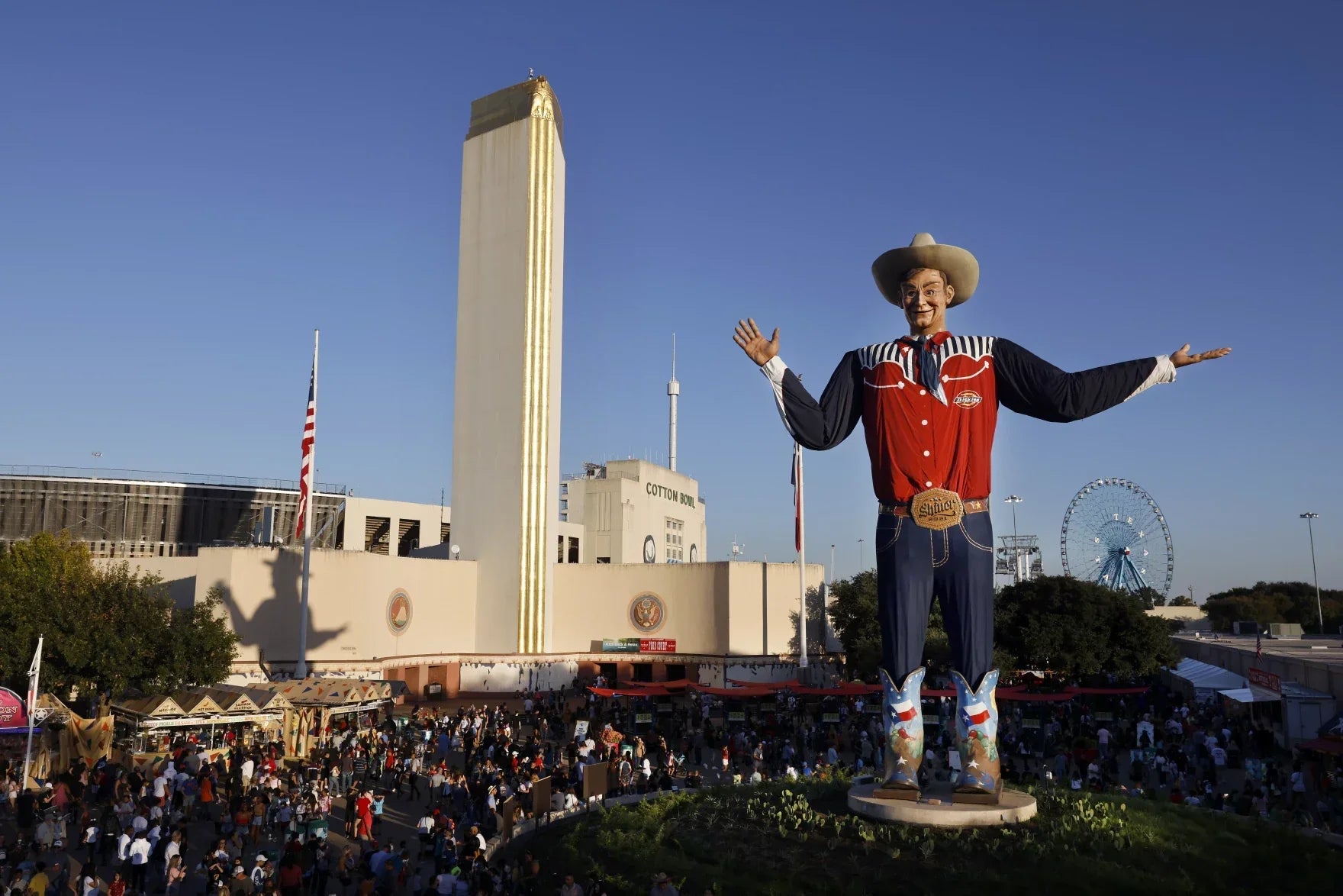There’s something inherently Texan about the State Fair of Texas: the bold flavours, the spirited crowds, the smell of fried everything, the towering cowboy greeting you as you enter. But beneath the rides and corny dogs lies a story that cuts deeper — one of ambition, reinvention, and contradictions. Let’s pull back the curtain and explore the history that fuels the fair beyond its glittering midway.
Roots in Ambition: The Fair’s Birth (1886–1904)
The modern State Fair of Texas traces its origins to 1886, when a group of Dallas businessmen chartered the Dallas State Fair & Exposition. In its first year, the fair drew approximately 14,000 visitors on opening day and closed with over 100,000 across its run. At its core, those early fairs spotlighted agriculture, livestock, and commerce — exhibitions that showcased Texas’s rural economy and connected a rapidly growing state.
By 1887, the Dallas fair merged with a rival Texas State Fair and Exposition, consolidating two competing visions. In 1904, the City of Dallas purchased the fairgrounds and guaranteed the fair a permanent autumn home in Fair Park, where it still thrives today.
Growth, Innovation & Identity (1905–Mid 20th Century)
As the Fair matured, it became a stage where technology, entertainment, and tradition intersected:
-
Auto shows debuted in 1913, a first for American state fairs.
-
During WWI (1918) and WWII (1942–44), the fairgrounds were repurposed for the war effort.
-
In 1929, the iconic Red River Rivalry football game between the University of Texas and Oklahoma University found its home at the fair’s Cotton Bowl — a tradition still going strong.
-
The Cotton Bowl Classic and other collegiate matchups cemented the stadium as a cultural cornerstone.
-
In 1952, the fair unveiled its most recognisable symbol: Big Tex, the towering cowboy who still greets visitors with a booming “Howdy, folks!”
But the fair also mirrored the times, including difficult chapters marked by segregation. For decades, African American visitors were restricted to certain days or areas. True integration didn’t arrive until the mid-20th century, as civil rights movements reshaped Dallas and beyond.
Modern Era: Food, Spectacle & Contention
By the late 20th century, the State Fair had transformed into a sprawling extravaganza:
-
The Texas Star Ferris wheel, then the largest in North America, debuted in 1985.
-
In 1988, the fair stretched to a 24-day run, reflecting its scale and ambition.
-
Food became its signature — deep-fried Oreos, fried butter, fried bacon-wrapped everything — a culinary playground of excess and invention.
-
Attendance consistently tops 2 million people, making it one of the largest state fairs in the U.S.
-
As a nonprofit, the fair reinvests in scholarships and Fair Park improvements, though it hasn’t escaped controversy around finances, land use, and community impact.
In 2012, tragedy struck when Big Tex caught fire, only to return in 2013, rebuilt and stronger — a symbol of resilience befitting Texas itself.
The Feedlot at the Fair
This living history isn’t just something we read about — it’s something we’ve experienced. Zach and Jaxton from The Feedlot made the trip this year and were lucky enough to attend the legendary Red River Showdown at the Cotton Bowl, where UT triumphed over OU in front of a roaring crowd. Being there in the middle of the sea of burnt orange and crimson was more than just watching a football game — it was stepping into a century-old tradition that’s woven into the identity of the fair itself.
For us, the day was a reminder of why Texas traditions resonate so strongly with what we do back home in Australia. Just like the fair, our food celebrates heritage, flavour, and the power of bringing people together.
Fun Facts About the Texas State Fair
-
Fletcher’s Corny Dogs debuted in 1942 and remain the fair’s most iconic food.
-
Big Tex stands 55 feet tall and weighs over 25,000 pounds.
-
The fairgrounds at Fair Park are a National Historic Landmark, with art deco architecture from the 1936 Texas Centennial Exposition.
-
The fair runs for 24 days, making it the longest-running state fair in the U.S.
-
The Texas Star Ferris wheel held the record as the tallest in North America for nearly 30 years.
Why the Texas State Fair Still Matters
For all its fried food and Ferris wheels, the Texas State Fair is more than entertainment. It is:
-
A cultural mirror — reflecting Texas’s growth, struggles, and triumphs.
-
A culinary laboratory — sparking trends and pushing boundaries in food.
-
A civic institution — rooted in Dallas’s Fair Park, year after year.
-
A personal connection — whether you’re a Texan or just inspired by Texas traditions, like us at The Feedlot, it leaves a lasting imprint.
The Texas State Fair is a space where history and flavour collide — and one where The Feedlot is proud to have walked, cheered, and eaten its way through.


